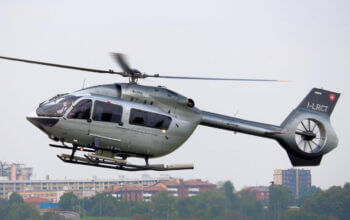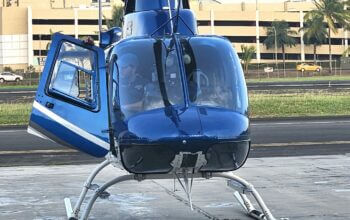Estimated reading time 7 minutes, 14 seconds.
A theatre closure team of about 80 personnel from the Canadian Joint Operational Support Group has descended on Camp Castor in northern Mali to begin packing up the Air Task Force that officially completed its forward aeromedical evacuation mission on Aug. 31.

From office supplies and furniture to helicopter parts and ammunition, the team will sort through thousands of kilograms of materiel to determine what can be left for allies and what must return to Canada.
“They are helping us account for all our materiel, making sure we have found every last washer and Post-It Note,” Col Travis Morehen, the air task force commander, told Skies in a recent interview.
While some furniture, computer monitors and keyboards may be donated to the German forces that operate the camp or incoming Romanian forces who will assume the aeromedical evacuation and transport roles, “aircraft parts, weapons, crypto, radios–that is being controlled very closely and being sent home by air,” said Morehen.
The arrival of the closure team marks the end of the Mali mission, part of Operation Presence, which began in August 2018 with the stand-up of a newly created medical evacuation capability comprised of three CH-147F Chinook and five CH-146 Griffon helicopters, along with about 250 aircrew, medical personnel, force protection, maintenance, headquarters and support staff.
The last members of the air task force will depart on Sept. 11, completing the first phase of a handover with a Romanian air detachment. The Romanian task force commander arrived in Gao on Aug. 29, part of a 12-person advanced party. As well, the last of four Royal Canadian Air Force CC-177 Globemaster flights touched down that day, helping the Romanians lift vehicles and sensitive equipment into Mali.
Once Romanian H215 Super Puma helicopters and the rest of their task force begin arriving in late September, a small team of Canadian pilots, doctors, intelligence and operations personnel will return to help guide the Romanians through the initial stand-up of their capability.
“I think that is where we will have the most impact,” said Morehen, noting that Canadian standard operating procedures – like sending a pilot to the planning room while the co-pilot starts the aircraft when a medevac request comes in – have already been shared for training purposes, but may need refining once Romanian crews are on the ground. Until then, the United Nations will provide medevac through contracted civilian helicopters.
Approximately 1,250 Canadian Armed Forces members have served on the 13-month mission. They have conducted 11 medical evacuations involving over 40 patients and completed more than 100 transport flights of about 2,800 troops and passengers and 370,000 pounds of cargo.
Transport flights ceased on July 31, but the aeromedical evacuation capability remained on short notice for 30 more days and responded to one call-out for assistance. In total, Canadian aircrews conducted over 4,000 flying hours between the two helicopter fleets.
Though temperatures cooled somewhat from the early summer’s searing 45-degree Celsius heat that kept helicopters hand-scorching hot hours after they had been shut down, August was one of the most challenging months for flying, Morehen observed.
“The density altitude has reduced, so the helicopters have more lift, but August is the most turbulent month when it comes to weather,” he explained. “Probably every other day we will have brief thunderstorms or heavy convective activity develop in the afternoons, so the lightning storms are phenomenal … we can see these spectacular lightning storms from hundreds of kilometres. But obviously that poses a significant weather risk to us … Our greatest challenge right now is to get an accurate and predictive weather assessment.”
The mission has also been a reminder of the challenges of operating tactical aviation at the end of a long, 7,000-kilometre supply chain. While 1 Wing, which Morehen commands, has accumulated significant experience sustaining the Griffon in Afghanistan and more recently in Iraq, Air Task Force Mali marked the first overseas deployment of the Chinook.
After some initial issues shipping parts through a distribution hub in Senegal, “we were able to get the full compliment of spares and tools into theatre, which allowed a minimal amount of down time waiting for parts back from Canada,” he said.
Particularly impressive was the 200-hour periodic inspection, which maintenance crews were able to complete in theatre in 13 to 14 days, despite punishing temperatures and high humidity. The inspection normally takes around 35 days in Canada, he noted.
“That was really a testament to their professionalism,” said Morehen.
To mitigate the worst of the heat when possible, flying was conducted during the day and preventative maintenance and inspections were performed at night.
What pleased Morehen the most, though, was the way in which the two tactical helicopter squadrons, 450 Squadron from Petawawa, Ont., and 430 Squadron from Valcartier, Que., united to form one team. “By the end they were functioning as one complementary maintence team. There was never an us-and-them between the two, which I found very refreshing and a real pleasure to watch.”
After over a year of researching and then standing up the forward aeromedical evacuation capability, Morehen acknowledged one of the goals will be to preserve it. He said 1 Wing would provide “whatever expertise and training opportunities” health services personnel might require to maintain their skills in the back of a helicopter, but the Wing itself has solidified its TTPs (tactics, techniques and procedures) for providing a quick reaction force or medevac. “I think those are activities we can build into our own battle procedure regardless of who we are carrying in the back.”
The importance of the capability was driven home for him just four days after arriving in Gao when a large-scale medevac was launched on Jan. 20 after Nusrat al-Islam wal Muslimeen, an Al-Qaeda-linked jihadist group, attacked a forward peacekeeping base in Aguelhoc, killing 10 soldiers and wounding 25.
“By mixed blessing, we were able to watch (the first rotation) execute this professional, efficient and effective capability right in front of our eyes,” he said. “That was probably the best handover we could have had. It really set the tone at the beginning of our tour of how important the mission was, that it had a real effect saving people’s lives, and we had to be continuously vigilant in our ability to conduct that mission.”









Canada’s decision to send an air support mission to Mali was widely seen as a move to bolster Canada’s bid for a non-permanent UN Security Council seat in 2021. Some have criticized the government for failing to provide more peacekeepers or to extend Canada’s commitment to UN missions like the one in Mali. The lack of extension may cause a failed bid to gain a seat in 2021. Is it important that we have a seat in the UN?